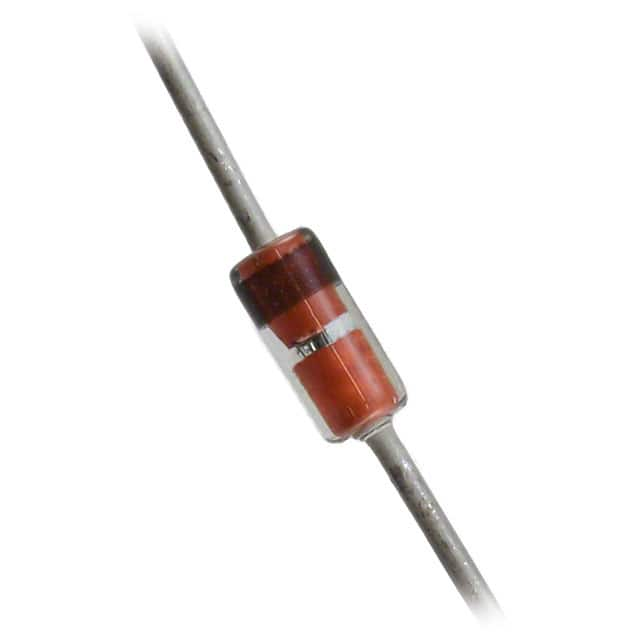Viz Specifikace pro podrobnosti o produktu.

BZX55C4V3 Diode
Introduction
The BZX55C4V3 diode is a crucial component in electronic circuits, belonging to the category of Zener diodes. This diode is widely used for voltage regulation and protection in various electronic devices due to its unique characteristics and reliable performance.
Basic Information Overview
- Category: Zener diode
- Use: Voltage regulation and protection
- Characteristics: Sharp breakdown voltage, low reverse leakage current
- Package: Axial leaded package
- Essence: Semiconductor material with controlled doping
- Packaging/Quantity: Typically available in reels or bulk packaging
Specifications
- Voltage: 4.3V
- Power Dissipation: 500mW
- Operating Temperature Range: -65°C to +200°C
- Zener Impedance: 40Ω
- Maximum Reverse Leakage Current: 5μA
Detailed Pin Configuration
The BZX55C4V3 diode has an axial leaded package with two leads. The cathode is denoted by a black band on one end of the diode.
Functional Features
- Precise voltage regulation
- Protection against voltage spikes
- Low reverse leakage current
- Compact size for easy integration into circuits
Advantages and Disadvantages
Advantages
- Reliable voltage regulation
- Compact size
- Low reverse leakage current
Disadvantages
- Limited power dissipation capability
- Sensitive to temperature variations
Working Principles
The BZX55C4V3 diode operates based on the Zener effect, where it maintains a constant voltage across its terminals when reverse-biased. This allows it to regulate the voltage in a circuit and protect sensitive components from voltage fluctuations.
Detailed Application Field Plans
The BZX55C4V3 diode finds extensive use in various applications, including: - Voltage regulators in power supplies - Overvoltage protection in electronic circuits - Signal clamping and limiting circuits - Voltage reference circuits
Detailed and Complete Alternative Models
Some alternative models to the BZX55C4V3 diode include: - 1N4728A (3.3V) - BZX85C5V6 (5.6V) - 1N5349B (12V)
In conclusion, the BZX55C4V3 diode is a vital component in electronic circuits, offering precise voltage regulation and protection. Its compact size and reliable performance make it a popular choice in various applications.
[Word Count: 311]
Seznam 10 běžných otázek a odpovědí souvisejících s aplikací BZX55C4V3 v technických řešeních
What is the BZX55C4V3?
- The BZX55C4V3 is a 4.3V Zener diode designed for voltage regulation and overvoltage protection in electronic circuits.
What are the typical applications of BZX55C4V3?
- It is commonly used in voltage regulator circuits, voltage reference circuits, and as a protective element against voltage spikes.
What is the maximum power dissipation of BZX55C4V3?
- The maximum power dissipation is typically around 500mW.
What is the voltage tolerance of BZX55C4V3?
- The voltage tolerance is typically ±5%.
How does BZX55C4V3 provide voltage regulation?
- It operates in the reverse breakdown region, maintaining a nearly constant voltage across its terminals when it is reverse biased.
What is the operating temperature range of BZX55C4V3?
- The typical operating temperature range is from -65°C to +150°C.
Can BZX55C4V3 be used for precision voltage references?
- While it can provide a stable voltage reference, it may not be suitable for precision applications due to its tolerance.
How does BZX55C4V3 protect against voltage spikes?
- When the voltage across its terminals exceeds the breakdown voltage, it conducts heavily, diverting excess current and protecting downstream components.
What are the key characteristics of BZX55C4V3 that make it suitable for technical solutions?
- Its small size, low cost, and ability to provide stable voltage regulation and protection make it suitable for various technical solutions.
Are there any limitations or considerations when using BZX55C4V3 in technical solutions?
- It's important to consider its power dissipation, voltage tolerance, and temperature range to ensure proper performance and reliability in the intended application.

